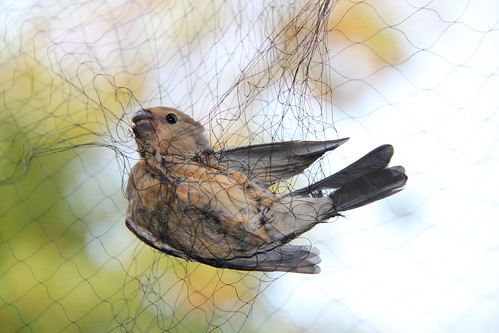隨著IUCN新的瀕危物種紅色名錄出爐,負責其中鳥類名單的保育組織──國際鳥盟發表報告指出,今年的極度瀕危鳥種數創下歷史新高。不過,部分相關的保育措施也見到初步成果。
「現在已有近200個鳥種出現滅絕危機。有許多原因影響牠們的生存,主要的因素包括棲息地消失、農業方式改變、外來種入侵和氣候變遷。若不著手解決這些問題,名單上的鳥種只會越來越多。」國際鳥盟科學政策與資訊總監Leon Bennun博士說。
最近被列入極度瀕危物種保護級別(Critically Endangered)的鳥種是非洲特有種白翅倭秧雞(Sarothrura ayresi)。其體型小如鴿子,行蹤難以捉摸,在南非中部和衣索比亞的高地沼澤掙扎求生。國際鳥盟的Martin Fowlie博士說,「白翅倭秧雞的棲息地──高緯度草原溼地遭到排水、農業模式改變、抽水、過度放牧和植被砍伐等人類活動的破壞而退化,讓白翅倭秧雞的生存岌岌可危。」
「南非和衣索比亞需要立即採取行動,確實瞭解該物種的生態,著手解決這些問題,才能拯救白翅倭秧雞。」Fowlie11月底在部落格上表示。國際鳥盟報告指出,南非部分地區已實施相關保護法律,且有4個以上的地點由地主親自保護。在衣索比亞,植被到10至11月才會被砍除做飼料,讓當地最大的白翅倭秧雞族群有時間繁殖不受打擾。
在中國南部和東南亞,黃胸鵐的數量(Emberiza aureola)因為人類濫用陷阱而減少。這個物種的數量曾經很多,2000年還被列為無危等級,現在卻被列為瀕危,只比極度瀕危好一級。
 不過最近的鳥類調查顯示情況也並非全然絕望。部分保育工作已經漸漸出現成果。信天翁是最受威脅的鳥種之一,但有2個信天翁物種因數量增加,滅絕風險降低了。生活在印度洋羅德里格島的羅島艷織雀(Foudia flavicans)和羅迪藪鶯(Acrocephalus rodericanus),由於保育工作奏效,保護級別也降低了。因保護島上流域而進行的棲息地保護和森林重建工作,加上未出現嚴重風暴,讓這些物種的數量得以回復。
不過最近的鳥類調查顯示情況也並非全然絕望。部分保育工作已經漸漸出現成果。信天翁是最受威脅的鳥種之一,但有2個信天翁物種因數量增加,滅絕風險降低了。生活在印度洋羅德里格島的羅島艷織雀(Foudia flavicans)和羅迪藪鶯(Acrocephalus rodericanus),由於保育工作奏效,保護級別也降低了。因保護島上流域而進行的棲息地保護和森林重建工作,加上未出現嚴重風暴,讓這些物種的數量得以回復。
然而,埃及和利比亞居民在地中海沿岸廣設鳥網(mist net)捕捉候鳥,近來成為公眾關注的議題。雖然政府建立了管制框架,但確實執法仍是個挑戰。根據目前估計,每年秋天有數百萬隻從歐洲和亞洲飛往非洲撒哈拉以南地區過冬的候鳥被捕捉。
「在這些國家,抓鳥是一種傳統。當地人主要捕捉的鳥種──鵪鶉是當地美食。捕食鳥類在當地是合法的。不過這種無差別、大規模的濫捕對其他非目標鳥種造成的影響,更令人憂心。」國際鳥盟遷飛網絡計劃資深計畫經理Marcus Kohler說。
埃及政府已宣布將和德國、瑞士和其他國家合作,進一步管理埃及地中海沿岸未受管制的狩獵活動和鳥網使用。
The number of bird species listed as Critically Endangered has soared to an all-time high, reports BirdLife International with the release of this year’s Red List for Birds. Even so, some conservation efforts are succeeding.
“Almost 200 species of bird are now in real danger of being lost forever,” said Dr. Leon Bennun, BirdLife’s director of science, policy and information. “They are being hit on multiple fronts. Habitat loss, agricultural changes, invasive species and climate change are the principle threats. Without these problems being addressed the list will continue to grow.”
The White-winged flufftail, Sarothrura ayresi, a small, elusive, dove-sized rail endemic to Africa, is the latest to join the lengthening list of species on the brink of extinction. This secretive bird clings to survival in the upland marshes of central South Africa and Ethiopia.
Dr. Martin Fowlie of BirdLife International says, “Destruction and degradation of its high altitude wet grassland habitat, including wetland drainage, conversion for agriculture, water abstraction, overgrazing by livestock and cutting of marsh vegetation, have driven it to this precarious state.”
“Urgent action is now needed in both Ethiopia and South Africa to better understand the species’ ecology and to address these threats and save it from extinction,” blogged Dr. Fowlie in late November.
Some South African sites have some legal protection, and at least four sites are protected by the landowners. At the largest Ethiopian breeding population, the vegetation is not cut for fodder until October-November, giving the White-winged flufftails time to breed without disturbance, BirdLife reports.
The Yellow-breasted bunting, Emberiza aureola, is disappearing due to uncontrolled trapping in its wintering grounds in southern China and Southeast Asia. This once common species, classified as of Least Concern as recently as 2000, is now considered Endangered, just one step below a Critically Endangered listing.
Yet the latest bird assessments are not all discouraging. There are signs that conservation action is working.
Two species of albatross, one of the most threatened bird families, are now considered to be at a lower risk of extinction after increases in their populations.
On the Indian Ocean island of Rodrigues, two species – the Rodrigues Fody, Foudia flavicans, and the Rodrigues Warbler, Acrocephalus rodericanus– have been downlisted as a result of conservation action.
Habitat protection and reforestation, employed to protect the island’s watershed, as well as the absence of catastrophic storms, have helped these species to recover.
The government of Egypt, in cooperation with Germany, Switzerland and other partners, has pledged to assess and further address the issue of unregulated hunting and bird netting practices along the Mediterranean coast of Egypt.
The hunting and trapping of migratory birds in Egypt and Libya, through the use of mist nets along vast stretches of the Mediterranean coast, have become issues of growing public concern. Regulatory frameworks are in place, the challenge lies in their enforcement.
“Bird trapping in these countries is an ancient tradition. The main target species, Common Quail, is a local delicacy,” said Marcus Kohler, BirdLife’s senior program manager for Flyways.
“It’s a legitimate way for local people to supplement their diet,” said Kohler. “However, the indiscriminate nature and scale of the trapping has now reached worrying proportions and is having an impact upon other species.”
Current estimates are that millions of birds are caught each autumn as they leave Europe and Asia for their wintering grounds in sub-Saharan Africa.
※ 全文及圖片詳見:ENS
※加入「環境資訊中心」粉絲頁,來給環境按個讚 https://www.facebook.com/enc.teia






